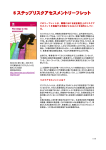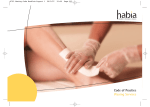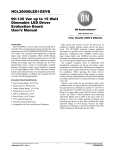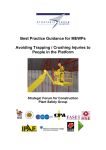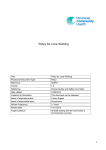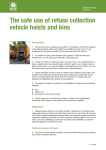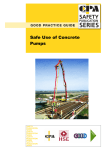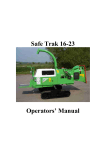Download Small Business Advice Pack
Transcript
Business Advice Pack HEALTH & SAFETY FOR SMALL BUSINESSES This pack contains important information Do Not Discard Working in Partnership With Local Businesses www.torfaen.gov.uk i:\outlookarchive\complete small business pack - updated 250909.doc 21/11/07 12:10 BUSINESS ADVICE PACK SECTIONS 1. About this pack 2. The Health and Safety of Great Britain\\ Be part of the solution What affect will this have on my business 3. Policies and Risk Assessments Health and Safety Policy Risk Assessment Guidance and Form Audit Prepaid Envelope 4. Welfare Welfare checklist 5 Smoke Free Checklist 6. First Aid First aid checklist 7. RIDDOR 8. Fire Safety 9. Young People 10. Advice Leaflets list i:\outlookarchive\complete small business pack - updated 250909.doc 19/10/07 10:03 HEALTH AND SAFETY AT WORK ETC ACT 1974 This information pack has been produced by Torfaen County Borough Council food, Health & Safety Team, to help you with your responsibilities relating to Health and Safety legislation. You are welcome to reproduce this material, provided that Torfaen County Borough Council is acknowledged as the source where applicable. The contents are relevant to both employers and employees and you are urged to share the pack with your staff and to keep it for future reference. If you are a new business and/or undertaking structural changes to your premises you may require Building Control approval. Please contact Building Control on 01495 766923 for further advice. You may need to seek further information/approvals from other departments of the Council and/or other organisations. You are advised, therefore, to contact a business adviser, for example Citizen's Advice Bureau, Chamber of Commerce, Small Businesses Association or Business Link, who may be able to guide you further. As well as containing information on the legal requirements, the pack contains checklists which enable you to check your level of compliance. It is suggested that you keep them to use again in the future. For further advice please contact Liz Vann Food, Health & Safety Team Planning & Public Protection Torfaen County Borough Council Floor 4 County Hall, Cwmbran, Torfaen, NP44 4WN Tel: 01633 647260 E-mail: [email protected] i:\outlookarchive\complete small business pack - updated 250909.doc 19/10/07 10:03 A strategy for workplace health and safety in Great Britain to 2010 and beyond This HSC/HSE strategy was designed to promote the vision of health and safety as a cornerstone of a civilised society and, with that, to achieve a record of workplace health and safety that leads the world. Working in partnership with Local Authorities, this strategy also informs our local service delivery process. The enforcement concept continues to give less emphasis to the traditional risk rating system and numbers of inspections (with the exception of the highest risk premises – Category A, which are a Welsh Assembly Government core performance indicator), to focus proactive interventions on those premises that nationally have been identified as causing the greatest number of incidents and accidents to employees and members of the public – and to use a wide range of intervention methods to achieve increased outcomes. The basis of enforcement action by the Authority is: Intervention – to assess, promote and enforce compliance. Investigation – to identify underlying causes and lessons to learn. Permissioning – as appropriate to ensure high risk activities are controlled. The Health and Safety of Great Britain\\ Be part of the solution This is the new strategy from HSE for the future of workplace health and safety - it follows the 2010 Strategy outlined above. The strategy identifies goals in the following key areas: the need for strong leadership; building competence; involving the workforce; creating healthier, safer workplaces; customising support for Small / Medium Size Enterprises (SME’S) avoiding catastrophe; and taking a wider perspective. The strategy also identifies a goal for HSE and Local Authorities in an area of work unique to them – investigating and securing justice. As Local Authorities tend to enforce mainly in the Small Medium Enterprises business sector, this may have a direct impact on the inspection programme in the future with more initiatives being undertaken to assist these types of businesses. i:\outlookarchive\complete small business pack - updated 250909.doc 19/10/07 10:03 In Great Britain in 2000, the same proportion of people had been injured at work since the early 1990s. The Health and Safety at Work etc Act (passed in 1974) was the most recent bit of law for health and safety at work. The government and the Health and Safety Executive (HSE) wanted to act and put more effort into managing health and safety to start reducing these numbers. Below are practical advice, evidence and some tools we have developed to help you in your business. Directors responsibilities for health and safety Ready Reckoner: reduce risks; cut costs HSE's new case studies show the business benefits of health and safety Worker involvement and consultation Directors' responsibilities for health and safety Directors' responsibilities for health and safety This guidance is for board members of all types of organisations in both the private and public sectors. The focus is mainly on the health and safety responsibilities of company directors. It will help them ensure that the health and safety risks arising from their organisations' activities are properly managed. Ready Reckoner: reduce risks - cut costs This website gives information on the business and economic costs from not managing health and safety adequately. Case studies are used to show how much work-related accidents and ill-health are costing businesses. Case studies show the business benefits of health and safety There are some case studies, published by the Health and Safety Commission (HSC), which set out the business case for good health and safety management. They span a wide range of industry sectors and public services. Each study describes an initiative or programme and its benefits in both health and safety and business terms. These can be found via the HSE website. Worker involvement and consultation Worker involvement and consultation is a key element of the Health and Safety Commission's "Strategy for workplace health and safety in Great Britain to 2010 and beyond". An organisation's greatest asset is its workforce. Employees are best able to spot issues and bring about real improvements. HSC will be working closely with our partners to take forward a range of measures to promote greater worker involvement in health and safety in the workplace. i:\outlookarchive\complete small business pack - updated 250909.doc 19/10/07 10:03 WHAT AFFECT WILL THIS HAVE ON MY BUSINESS? The highest risk premises (category A) will be subject to routine inspections on a risk based programmed basis, and based on the appropriate HELA guidance. All premises are risk rated in accordance with this guidance, in order to determine which premises should be included within this inspection programme. All other premises will be inspected using evidenced based intelligence and in accordance with the All Wales Plan. Work will be targeted as appropriate to ensure that HSC/HELA objectives are met wherever possible New premises are sent a questionnaire and a desk top assessment carried out. Where necessary an inspection is then carried out as soon as is practicable, having regard to the likely risk the premises present in terms of their size and the types of operation carried out there and having regard to the current guidance. Premises presenting known high risks will be inspected by senior/experienced officers with specialist knowledge of the appropriate legislation. Lower risk premises may be globally risk rated and subject to alternative enforcement where it is clear that they would normally fall outside the inspection programme. As well as inspections, other interventions will be carried out as appropriate and particularly in respect of low risk premises. These may take the form of questionnaires, informal visits or other actions, although inspections of low risk premises may still take place where this is considered the best use of resources. In addition to programmed risk based inspections, other inspections will be carried out as appropriate where Intelligence is received as a result of complaints or other information Topic based or special project inspections and other actions are being carried out An intervention action such as a questionnaire is considered inappropriate, for example where the risk rating may no longer be accurate. Where no response has been received to an intervention action such as a questionnaire, or where the validity of such an intervention requires validation. Where specialist knowledge is required but is not available in house, this will be sought from other authorities as appropriate. The Authority will respond as appropriate to any additional inspections or other work required by the Health and Safety Executive or other such bodies. New legislation is responded to as necessary, through additional inspections and/or information for affected businesses. Where the legislation is planned in advance it will be included in the Service Improvement Plan. Local Authorities from April 2005 have to ensure they inspect business premises using resources available to them concentrating on the following priority topic areas. i:\outlookarchive\complete small business pack - updated 250909.doc 19/10/07 10:03 Enclosed in this section are some checklists based on the five topic inspections to help you with your risk assessments. Further advice can be found in leaflet Take a Look at Health and Safety. INDG385 which can be obtained from HSE info line 08701 545500 or via our web site www.torfaen.gov.uk i:\outlookarchive\complete small business pack - updated 250909.doc 19/10/07 10:03 FALLING FROM HEIGHT Health & Safety Checklist A fall is the consequence of other more deep seated reasons, e.g. poor training, inadequate supervision and management, lack of maintenance of access equipment and structures and the provision of unsuitable equipment or implementation of unsuitable working procedures. The list below gives guidance on some of the things to be considered when working at height is involved. (The list is not exhaustive but can be used as a starting point for a more detailed list based on your own specific circumstances). More detailed checklists for ladders and window cleaning are available. General Yes No N/A 1. Can the work be done from ground level? 2. Have all stages of the job involving working at height been planned and risk assessments carried out? 3. Is there a safe method of access to work at height? 4. Is all equipment to be used of the correct type, well Maintained and being used as intended? 5. Are employees trained and given adequate instruction and information? 6. Is there adequate supervision? 7. Are there any fragile surfaces/unsafe areas where the work is being carried out? 8. Are there adequate barriers or other edge protection to stop falls from open edges of buildings/gangways? 9. Where persons might fall 2m or more, is fencing provided with a minimum of two horizontal guard rails at least 1100mm above the surface from which the person might fall? 10. Are holes and openings securely fenced off or provided with fixed, clearly marked covers? i:\outlookarchive\complete small business pack - updated 250909.doc 21/11/07 12:10 Yes No N/A Ladders 1. Are ladders the right equipment to use for the job, or should a scaffold be provided? 2. Are all ladders in good condition? 3. Are ladders secured near the top (even if only in use for a short time)? 4. If ladders cannot be secured at the top, are they secured near the bottom, weighted or footed, to prevent slipping? (A second person standing at the foot of a ladder to prevent it slipping is effective only with ladders less than about 5m long). 5. Do ladders rise at least 1.07m (3ft 6in) above their landing places or the highest rung used? If not, are there adequate handholds? 6. Are ladders always placed so that there is no danger from moving vehicles, overhead cranes or electricity lines? 7. Are ladder strays, or similar devices, used to avoid placing Ladders against fragile supports, e.g. plastic gutters? 8. Are ladders positioned on a firm and level footing? 9. Are the ladders properly positioned for access? Fixed Ladders 1. Are they of sound construction? 2. Do they have firm horizontal rungs? 3. Do stiles extend at least 1100m above the highest landing level? 4. Are they regularly checked and maintained? 5. Do fixed ladders, which pass through floors, have guarded openings? i:\outlookarchive\complete small business pack - updated 250909.doc 19/10/07 10:03 6. Do fixed ladders of more than 2.5m length have safety Lops at a minimum of 900m intervals? Yes No N/A Tubular Scaffolds 1. Are all components inspected by a competent person prior to use? 2. Has the scaffold been designed, erected (including alterations or dismantling) under the supervision of a competent person and by competent and experienced workers? 3. Is there safe access to the scaffold platform? 4. Are all uprights provided with base plates (and where Necessary timber sole plates) or prevented in some other way from slipping or sinking? 5. Is the scaffold secured to the building in sufficient places to prevent collapse? 6. Are working platforms fully boarded? 7. Are there effective barriers or warning notices to stop people using incomplete scaffold, e.g. one not fully boarded? 8. Are there adequate guard rails and toe boards at every side From which a person could fall more than 1.98m (6ft 6in)? 9. Does a competent person inspect the scaffold regularly, i.e. at least once a week (and always after bad weather) to ensure no change has occurred or unplanned/unauthorised alterations have been carried out? 10. Are the results of inspections recorded (including defects that were corrected during the inspections) and the records signed by the person who carried out the inspections? 1. Do roofs requiring access have a suitable means of access? 2. Are crawling ladders or crawling boards used on roofs that slope more than 10? Roofwork i:\outlookarchive\complete small business pack - updated 250909.doc 19/10/07 10:03 Yes No N/A 3. If there are no ladders/boards do the roof battens provide a safe handhold and foothold? 4. Are there enough barriers or other edge protection to stop people or materials falling from sloping/flat roofs? 5. Where people could fall over the edge of the roof, are guard rails and toe boards installed or anchorage points for safety harnesses? 6. Are safety harnesses used where appropriate to prevent people falling over the edge of the roof? 7. Are harnesses checked by a competent person? 8. Are there safeguards to prevent falls through the roof? 9. Are crawling boards provided where people work on fragile materials such as asbestos cement sheets or glass? Are warning notices posted? 10. Are suitable guard rails, covers etc. provided where people pass or work near such fragile materials? 11. Are roof-lights properly covered or provided with barriers? 12. During sheeting operations, are precautions taken to stop people falling from the edge of the sheet? 13. Is roofwork discontinued in adverse weather conditions? 14. Are precautions taken to stop debris falling onto others Working under the roofwork? References: “Working at Height” pages 10-11 - Constructions Industry Publications Ltd. Construction Site Safety Checklist – HSE Site Safety Handbook – CIRIA “Site Safety Simplified – Aspects of Safety for Smaller Firms” – HSE “The Absolutely Essential Health and Safety Toolkit for the Smaller Construction Contractor” – HSE. INDG344 For more advice on health & safety at work, with free publications to download, visit www.torfaen.gov.uk i:\outlookarchive\complete small business pack - updated 250909.doc 19/10/07 10:03 NOTE: This information is not exhaustive and does not necessarily indicate compliance with any provision of the Health & Safety at Work etc. Act 1974 or any Regulation under them. Day-to-day monitoring of good working practice is a clear responsibility of the employer. i:\outlookarchive\complete small business pack - updated 250909.doc 19/10/07 10:03 MANUAL HANDLING Health and Safety Checklist Yes No N/A 1. Is it reasonable to avoid moving the load? 2. Is it practicable to use mechanical aids at reasonable cost? 3. Have the staff been trained on manual handling? 4. Do tasks involve the following: (a) holding the load away from the trunk? (b) twisting? (c) stooping? (d) reaching upwards? (e) excessive vertical movement? f) long carrying distances? (g) strenuous pushing or pulling? (h) unpredictable movement of loads? (i) repetitive handling? (j) a work rate imposed by a process? 5. Are rest and/or recovery periods allowed for? 6. Are instructions given to staff not to lift loads, without supervision and assistance, that are: (a) heavy? (b) bulky/unwieldy? (c) difficult to grasp? (d) unstable/unpredictable? (e) intrinsically unsafe (e.g. sharp)? In the working environment, is there: (a) space ample to allow good posture? (b) floor surface of good quality? (c) floor and/or work surface level? (d) ambient temperature/humidity reasonable? (e) lighting level sufficient? (f) air movement within reasonable limits? 7. i:\outlookarchive\complete small business pack - updated 250909.doc 19/10/07 10:03 8. Can the job be carried out: (a) without special capability? (b) by those with a health problem? (c) by those who are pregnant? (d) without special information/training? (e) without personal protective equipment? Yes No N/A 9. Does clothing or personal protective clothing allow free movement and posture in the manual handling task? 10. Has training been given to all staff on health and safety matters related to manual handling tasks and also the use of mechanical handling aids? For more advice on health & safety at work, with free publications to download, visit www.torfaen.gov.uk i:\outlookarchive\complete small business pack - updated 250909.doc 19/10/07 10:03 DISPLAY SCREEN EQUIPMENT Self Assessment Checklist Name: Group: No. of hours worked: Date: Division: Average time spent on working with DSE: This checklist will help you to carry out an assessment of your workstation. The form should be completed and passed to your manager as soon as it has been completed. DISPLAY SCREENS Yes No 1. Are the characters clear and readable? 2. Is the text size comfortable to read? 3. Is the image stable, i.e. free of flicker and jitter? 4. Is the screen's specification suitable for its intended use? 5. Are the brightness and/or contrast adjustable? 6. Does the screen swivel and tilt? 7. Is the screen free from glare and reflections? 8. Are adjustable window coverings provided and in adequate condition? KEYBOARDS 9. Is the keyboard separate from the screen? 10. Does the keyboard tilt? 11. Is it possible to find a comfortable keying position? 12. Are the characters on the keys readable? i:\outlookarchive\complete small business pack - updated 250909.doc 19/10/07 10:03 Yes No MOUSE, TRACKBALL, etc 13. Is the device suitable for the tasks it is used for? 14. Is the device positioned close to you? 15. Is there support for your wrists and forearms? 16. Does the device work smoothly at a speed that suits you? 17. Can you easily adjust software settings for speed and accuracy of pointer? SOFTWARE 18. Is the software suitable for the task? FURNITURE 19. Is the work surface large enough for all the necessary equipment, papers etc? 20. Can you comfortably reach all the equipment and papers you need to use? 21. Are surfaces free from glare and reflection? 22. Is the chair suitable? 23. Is the chair stable? 24. Does the chair have a working: seat back height and tilt adjustment? seat height adjustment? swivel mechanism? castors or gliders? 25. Is the chair adjusted correctly? 26. Is the small of the back supported by the chair's backrest? 27. Are forearms horizontal and top of the screen approximately 4 inches (10mm) below eye level? i:\outlookarchive\complete small business pack - updated 250909.doc 19/10/07 10:03 28. Are feet flat on the floor, without too much pressure from the seat on the backs of the legs? Yes No ENVIRONMENT 29. Is there enough room to change position and vary movement? 30. Is the lighting suitable, e.g. not too bright or too dim to work comfortably? 31. Does the air feel comfortable? 32. Are levels of heat comfortable? 33. Are levels of noise comfortable? 34. Do you use a lap top computer on a regular basis? 35. Have you experienced any discomfort or other symptoms which you attribute to working with your VDU? OTHERS cont'd 36. Have you been advised of your entitlement to eye and eyesight testing? 37. Do you have regular breaks/changes of duties working away from your VDU? 38. Have you been trained to operate your software? 39. Have you had sufficient information or training on setting up your workstation? 40. Have you read and understood the Council's D.S.E. policy? 41. Has the checklist covered all the problems you may have working with your DSE? If not please make additional comments below:- 42. Have you received and read a copy of the HSE leaflet 'Working with VDU's' (INDG 36 rev 2) i:\outlookarchive\complete small business pack - updated 250909.doc 19/10/07 10:03 Any other comments:- a) Employee Signature …………………………………… Date …………………… b) Reviewed by Manager Name: ……………………………………………………. Date: …………………... c) Remedial action required: …………………………………………………………... …………………………………………………………………………………………. …………………………………………………………………………………………. d) Date completed: ……………………………………………………………………... For more advice on health & safety at work, with free publications to download, visit www.torfaen.gov.uk i:\outlookarchive\complete small business pack - updated 250909.doc 19/10/07 10:03 SLIPS, TRIPS AND FALLS Health and Safety Checklist General Yes No 1. Are floors uneven/damaged? 2. Do electric cables trail across pedestrian routes? 3. Is the floor covering damaged and a trip hazard? 4. Do rugs/mats/carpets curl at the edges/need fixing to the floor? 5. Are floor surfaces slippery when dry? 6. Are floor surfaces slippery when wet? 7. Do cleaning materials make the floor slippery? 8. Do residues build up on floor surfaces/ground making it slippery? A “YES” response to any of the above requires risk assessment/remedial measures to be taken if controls are inadequate. Procedures/Working Practices/Workplace 9. Are lighting levels adequate on all traffic or pedestrian routes? 10. Where there are changes in levels, is lighting adequate and the change in level highlighted by, for example, a colour change/hazard tape? 11. Are handrails provided where appropriate, where there are level changes? 12. Do all staircases and steps have handrails where appropriate? 13. Are procedures in place to immediately clean up spillages? 14. If greasy liquids are spilled, is a suitable cleaning agent available and used? i:\outlookarchive\complete small business pack - updated 250909.doc 19/10/07 10:03 Yes No 15. Are appropriate signs used after floors have been cleaned and an alternative bypass route provided? 16. Are passageways/stairs/escape routes kept clear? 17. Are articles properly stored and put away so they do not cause obstructions? 18. Are safe working procedures adopted when transporting items up or down stairs? 19. Are ladders inspected and maintained? 20. Are damaged ladders taken out of service at once and disposed of? 21. Are safe working procedures adopted when using ladders/ working at height? 22. Are openings in floors fenced off? 23. When workmen/cleaners are working on site, does risk assessment include creation of tripping/slipping hazards? 24. Is provision of appropriate footwear considered in risk assessment in relation to slips, trips and falls? 25. Are risk assessments always done before working at height, and suitable controls in place? 26. In a workplace where flooring can be slippery, do you wear non-slip shoes? A “No” response to any of the above requires risk assessment/remedial measures to be taken. i:\outlookarchive\complete small business pack - updated 250909.doc 19/10/07 10:03 Other comments: Division: Group: Officer: For more advice on health & safety at work, with free publications to download, visit www.torfaen.gov.uk i:\outlookarchive\complete small business pack - updated 250909.doc 19/10/07 10:03 WORKPLACE TRANSPORT SAFETY Health & Safety Checklist Workplace transport means any vehicle used in a work setting. Specifically excluded from this advice are transport on the public highway, air, rail and water transport, specialised transport used in underground mining, agriculture and construction. However, some of the same basic principles may apply. Statistical Background Accidents involving vehicles at work account for a disproportionately large number of fatalities at work, i.e. people are more likely to be killed in accidents involving vehicles. Provisional figures for 2000/01 workplace transport accidents are as follows:- Accident Over 3 day Major injury Fatal injury Struck by moving vehicle 3472 1159 69 Collapse/overturn of vehicle 171 85 19 Fall from vehicle 1428 994 4 Materials falling from vehicle 786 252 7 Total 5857 2490 99 (Source: “Preventing workplace transport accidents”. Discussion document 2002) i:\outlookarchive\complete small business pack - updated 250909.doc 19/10/07 10:03 These statistics indicate that vehicle activities can be very dangerous and need to be properly managed to ensure a safe workplace. The Health and Safety Commission has decided that workplace transport is a priority hazard and should therefore be an area of health and safety to be targeted. LEGISLATION Health and Safety at Work etc. Act 1974 Employers have a duty to provide: A safe place of work, including safe entrance and exit Safe systems of work Safe plant that is maintained Safe handling, use, storage and transport of articles and substances Information, instruction, training and supervision for employees Management of Health and Safety at Work Regulations 1999 Employers have a duty to carry out risk assessments to: Identify the hazards associated with their work activities Identify who is at risk Evaluate the risk Where risks are not adequately controlled, take steps to reduce the risk Where there are 5 or more employees, to record the significant details of the risk assessment Review and revise the risk assessment where changes that mean it is no longer relevant As an initial step in the risk assessment process the workplace transport checklist can be used to identify any hazards. i:\outlookarchive\complete small business pack - updated 250909.doc 19/10/07 10:03 CHECKLIST The Workplace Yes No N/A 1. Are vehicles and pedestrians kept safely apart? 2. Are there suitable pedestrian crossing points on vehicle routes? 3. Are there suitable parking areas for all parking needs? 4. Do the vehicle routes avoid sharp or blind bends? 5. Are there one-way routes to reduce the risk of collisions? Traffic Routes 1. Are they suitable for the type and quantity of vehicles that use them? 2. Are they of sufficient width? 3. Are they well constructed with firm and even surfaces? 4. Are they well maintained? 5. Are they marked where necessary, e.g. to indicate the right of way at junctions? 6. Are signs indicating direction, speed limit, give way and no entry, etc. provided where applicable? The Vehicles 1. Are they suitable and safe for the work they are being used for? 2. Do they have suitable and effective service and parking brakes? 3. Are horns, lights, reflectors, reversing lights and other appropriate safety features provided? i:\outlookarchive\complete small business pack - updated 250909.doc 19/10/07 10:03 Yes No N/A 4. Are they provided with seats and, where necessary, seat belts that are safe and comfortable for the driver? 5. Are dangerous parts of vehicles guarded, e.g. power take-offs chain drives, exposed exhaust pipes? 6. Is protection provided against bad weather conditions/ unpleasant environments, e.g. cold, dirt, dust, fumes, excessive noise/vibration where appropriate? 7. Is access to and exit from the cab, and other parts needing to be reached, safe? 8. Is protection for the driver in the event of overturn/to prevent the driver being hit by falling objects provided where appropriate? 9. Do drivers carry out basic safety checks each time before using vehicles? 10. Is regular preventative maintenance, at predetermined intervals of time/mileage, carried out? Drivers and Other Employees 1. Do you check the previous experience of your drivers and test them to ensure they are competent for the particular vehicle they use? 2. Do you provide training on how to do the job and information about particular hazards? 3. Do you have a planned programme of refresher training for drivers and other employees to ensure their continued competence? The Job 1. Do your drivers drive with care, e.g. use the correct routes, drive within the speed limit and follow site rules? 2. Do drivers park safely and in safe locations? i:\outlookarchive\complete small business pack - updated 250909.doc 19/10/07 10:03 Yes No N/A 3. Are employees using safe working practices, e.g. when unloading/loading, securing loads, carrying out maintenance, etc. 4. Do drivers/other employees have to rush to complete their work on time, or is there a risk of accidents caused by fatigue as a result of excessive working hours? 5. Are supervisors, driver, other employees, contractors and visiting drivers aware of site rules and their own responsibilities in terms of maintaining a safe workplace? Vehicle Activities 1. Is the need for reversing moves kept to an absolute minimum? 2. If reversing is absolutely necessary, is it undertaken safely and in safe areas? 3. Could one-way systems be introduced on routes to reduce the need for reversing manoeuvres? 4. Are reversing areas identified/marked so that they are clear to drivers and pedestrians? 5. Are non-essential personnel excluded from areas where reversing is common? 6. Is there a signaller (banksman) to direct reversing vehicles? 7. Are external side-mounted and rear view mirror provided on vehicles to provide all round optimum visibility? 8. Are vehicles provided with reversing alarms? Parking 1. Do drivers (including those parking private cars) park in safe locations? 2. Do all drivers use designated parking areas only? 3. Do drivers always ensure vehicles and trailers are securely braked and secured before leaving them parked? i:\outlookarchive\complete small business pack - updated 250909.doc 19/10/07 10:03 Yes No N/A Loading and Unloading 1. Are loading/unloading activities carried out using safe systems of work on ground that is flat, firm and free from pot-holes? 2. Are vehicles braked and stabilised, as appropriate, to prevent unsafe movements during loading/unloading operations? 3. Is loading/unloading carried out as far as possible so that the load is spread evenly to avoid the vehicle or trailer becoming unstable? 4. Are checks made to ensure loads are secured and arranged so that they cannot move about, e.g. slide forward if the driver has to brake suddenly or slide off if the vehicle has to negotiate steep inclines? 5. Are vehicles checked to ensure they are not loaded beyond their capacity? This checklist is not necessarily comprehensive or relevant to all work situations. References: HELA Strategic Plan 2001-04 HSE “Workplace Guidance for Employees” – HSE136 HSE “Managing Vehicle Safety at the Workplace” leaflet for employers – INDG199L Preventing Workplace Transport Accidents – discussion document 2002 For more advice on health & safety at work, with free publications to download, visit www.torfaen.gov.uk/safety i:\outlookarchive\complete small business pack - updated 250909.doc 19/10/07 10:03 INDICATOR TOOL FOR WORK RELATED STRESS Background The Indicator Tool is a 35-item questionnaire relating to the six primary stressors identified in the Management Standards on Work Related Stress. The items are based on the best available evidence linking work design to health outcomes. It has been designed to support the process described in the Management Standards by providing a broad indication or organisations of how their workforce rate their performance in managing the risks associated with work related stress. The Indicator Tool can be used as a standalone measuring device or alternatively the items can be included in another question set, such as a pre-existing staff survey. It is recommended that the HSE Analysis Tool be used to score the responses, regardless of whether it is used as a standalone measuring device or incorporated into a wider staff survey. If you use these questions in another survey, it is important that you retain the same questions text, question order and response scale. You must do this if you wish to analyse the responses using the HSE analysis tool and to compare you data with others who have. The HSE Analysis Tool allows for the input of up to four items of demographic information to help you analyse responses. When conducting your survey, you may find it useful to ask respondents to indicate their location, department, job type etc. You should avoid doing this if using a very small sample as anonymity may be compromised. It is recommended that the Indicator Tool is not used as the only measure of stress within an organisation. The results from the Indicator Tool should be confirmed by discussing the findings with employees and also by considering other data that is available within the organisation, such as sickness absence rates, employee turnover etc. See Step 3 of the website for further guidance. This User Manual provides general guidance on various aspects of using the Indicator Tool in a survey to gather the opinion of the workforce. Areas covered in this User Manual include the following: Selecting a sample Getting a good response rate Analysing the results. Additional resources are included in the Appendices including: An example covering letter for a staff survey A checklist for using the Indicator Tool. For further assistance on the use of the Indicator Tool please visit our website at www.Torfaen.gov.uk i:\outlookarchive\complete small business pack - updated 250909.doc 19/10/07 10:03 Stress can be defined as "the adverse reaction people have to excessive pressure or other types of demand placed on them". Pressure is part and parcel of all work and helps to keep us motivated. But excessive pressure can lead to stress which undermines performance, is costly to employers and can make people ill. Why do we need to tackle stress? Commissioned research has indicated that: about half a million people in the UK experience work-related stress at a level they believe is making them ill; up to 5 million people in the UK feel "very" or "extremely" stressed by their work; and work-related stress costs society about £3.7 billion every year (at 1995/6 prices). The key messages on stress are: Work-related stress is a serious problem. Tackling it effectively can result in significant benefits for organisations. There are practical things organisations can do to prevent and control workrelated stress. The law requires organisations to take action. Resources available: HSE's Management Standards for Stress, and how to use them. The Live Issues page, which features latest news on stress at work . Details of HSE's published guidance on tackling work-related stress . HSE's online Stress Solutions Discussion Group - a forum for organisations to share good practice in stress prevention. A selection of case studies and an example of a stress policy. Details of HSE's research on stress at work. Advice for individuals and managers of individuals suffering from stress-related ill health. Related issues: Stress also links with several other areas of concern, including: Musculoskeletal disorders; Bullying; Workplace violence; Smoking, and drugs and alcohol in the workplace. For more advice on health & safety at work, with free publications to download, visit www.Torfaen.gov.uk i:\outlookarchive\complete small business pack - updated 250909.doc 19/10/07 10:03 HEALTH & SAFETY POLICY Employers of 5 or more Staff If you employ five or more people you must, by law, have a written statement of your health and safety policy. This should be your own statement, specific to your firm, setting out your general policy for protecting the health and safety of your employees at work and the organisation and arrangements for putting that policy into practice. Under section 2(3) of the Health and Safety at Work etc. Act 1974. The written statement must: State your general policy on health and safety Describe the organisation and arrangements for carrying out your policy Be brought to the notice of all your employees Be revised whenever appropriate, and every revision must be brought to your employees’ attention. Please refer to HSE leaflet "Introduction to Health and Safety" INDG259 (rev1) available to download via our website www.Torfaen.gov.uk i:\outlookarchive\complete small business pack - updated 250909.doc 19/10/07 10:03 RISK ASSESSMENT PROCEDURE Guidance for Commercial Premises Background Regulation 3 of the Management of Health and Safety At Work Regulations 1999 places an absolute duty on employers to carry out a ‘suitable and sufficient’ risk assessment on the health and safety risks to his employees and others that may be affected by his undertaking (i.e. members of the public, residents, contractors, cleaners, maintenance workers etc). Requirements for a ‘suitable and sufficient’ risk assessment To comply with the Regulations the risk assessment must be “suitable and sufficient”, i.e. must: 1. Identify all the hazards associated with the work activity and evaluate the risk arising from those hazards, taking into account current legal requirements 2. Record the significant findings that are reasonably foreseeable. Trivial risks can be ignored. 3. Identify any employee/group of employees especially at risk (e.g. young persons, new & expectant mothers, disabled persons etc). 4. Identify others who may be at risk (e.g. visitors, contractors, members of the public etc). 5. Evaluate existing controls, decide whether they are satisfactory. action should be taken? 6. Evaluate the need for information, instruction, training and supervision. 7. Estimate the probability/likelihood of the occurrence of an accident, incident or illhealth as a result of inadequately controlled risk, and record this. 8. Respond immediately to any circumstances arising from the assessment where serious and imminent risk could arise. 9. Provide an action plan, giving information and implementation of additional controls, in order of priority and with a realistic timescale. 10. Monitor the action plan to ensure it is being implemented. 11. Review risk assessments when there have been significant changes (i.e. changes to equipment, personnel, work activities, etc). It is considered good practice to review annually as a matter of routine. i:\outlookarchive\complete small business pack - updated 250909.doc 19/10/07 10:03 If not, what Risk Assessment Procedure This may appear to be a complicated process. This procedure is designed as an easy to follow step-by-step approach using standard documentation. The procedure for carrying out risk assessments is as follows:1. Identify the hazards. (“hazard” is something which could cause harm and may not just be the obvious physical hazards that you can see – i.e. lone working, occupational stress, legionella etc). Think about the 4 P’s – Premises, Processes, People and Plant. 2. List the individuals or groups of people who might be harmed. 3.1 Evaluate the risk by use of the risk rating system. (“Risk” is the chance that somebody will be harmed by the hazard) The risk rating is determined by giving a numerical value to – the likely occurrence, and the potential severity of the consequences. The risk rating = likely occurrence x potential severity Table 1 - shows numerical values for likely occurrence and potential severity with examples of each numerical value. Numerical Value Likely Occurrence Example Numerical Value 1 Most unlikely No record of occurrence 1 Potential Severity of Conseque nces Low 2 Possible occurrence Foreseeable Hasn’t occurred in last year. 2 Minor 3 Occasional Has/could occur approx. once a year 3 Significant i:\outlookarchive\complete small business pack - updated 250909.doc 19/10/07 10:03 Example No injury expected or injury unlikely to need medical attention. Able to carry out normal duties May need first aid. Short break from duties. Treated on spot. Injury results in inability to do normal duties. Off work more than 3 days, but less than 3 weeks 4 5 3.2 Frequent Occurs more than once a year; not as often as weekly Common Occurs weekly or more often; inevitable. 4 Major 5 Permanent disability or fatality. Needs qualified medical attention. Unable to do normal duties for more than 3 weeks. Intermittent incapacity. Unable to do normal job, replacement, retirement Multiply the numerical value for likely occurrence by potential severity, to give a numerical value for risk rating and the priority for action. (See Table 2) Table 2 - Risk Rating Potential Severity (PS) Likely Occurrence (LO) 1 2 1 2 3 4 5 1 2 3 4 5 2 4 6 8 10 3 4 RISK RATING = (LO) x (PS) 3 4 6 8 9 12 12 16 15 20 5 5 10 15 20 25 Risk Ratings with values greater than 4 are considered as significant and need further action to reduce the risk. Resolve highest risk ratings first. Low, medium and high risk are not used in this procedure, to reduce variation in individuals’ interpretation. 4. In controlling risks apply the principles below, if possible in the following order: Elimination – do the work in a different way, repair the damaged floor, replace the defective equipment etc. Substitution – use a less hazardous chemical, organise the work in a different way Engineering controls: design changes (alter your workstation, change the height of the computer monitor etc) Segregation/isolation (barriers, sound screens, enclosures etc) Administrative/management controls – changing/improving work procedures, training, instruction, supervision etc Personal Protective Equipment (safety glasses, hard hats etc) – should only be used as a last resort when a hazard cannot be sufficiently controlled by other controls. i:\outlookarchive\complete small business pack - updated 250909.doc 19/10/07 10:03 5. The risk assessment should be reviewed at least annually or before if there are any significant changes in work practices, equipment, etc or in the event of an accident, near miss etc. The ‘Risk Assessment Summary’ form can be used to list the hazards, people at risk, the risk ratings, controls and risks not adequately controlled, further controls needed and the action timescale. Additional Sources of information: Management of Health & Safety at Work Regulations 1999 Approved Code of Practice (L21) ISBN 0-7176-2488-9 Price £8.00 HSE Books - 01787 881165 ‘Five Steps to Risk Assessment’ INDG163 downloadable free of charge from the HSE online, via our website at www.torfaen.gov.uk i:\outlookarchive\complete small business pack - updated 250909.doc 19/10/07 10:03 RISK ASSESSMENT SUMMARY Site/task etc: Date: Completed by: Risk rating List of hazards Persons at Risk (Individuals/Groups) LO x PS List existing controls in place List further controls needed eg. 3 x 2 =6 LO = Likely occurrence PS = Potential severity of consequence Where risk ratings have values greater than 4 the risk is considered significant and action is necessary to reduce the risk i:\outlookarchive\complete small business pack - updated 250909.doc 21/11/07 12:10 Action timescale HEALTH & SAFETY AUDIT Please take a few moments to complete this important questionnaire and return in the enclosed freepost envelope. If you normally receive a visit from the Health & Safety Executive (HSE) please still complete the questionnaire to enable us to update our records. For help and advice on completing the questionnaires go to our website at www.torfaen.gov.uk which has comprehensive information and a wide range of free leaflets. Alternatively, printed versions of leaflets are available from HSE Books, telephone 01787 881165. If you have any additional queries or require any further assistance please telephone 01633 647622 and ask to speak to the Environmental Health Officer/Enforcement Officer who covers your area. Alternatively, you can e-mail us at: [email protected] Name of Address: Business: _____________________________ ________________________________ Tel No: ______________ ________________________________ _____________ ________________________________ Fax No: ______________________ ________________________________ E-mail: ________________________________ Website: i:\outlookarchive\complete small business pack - updated 250909.doc Post Code: ______________________ 21/11/07 12:09 Number of employees: Type of Premises Please tick: Retail e.g. shop Wholesale e.g. warehouse Office Catering Hotel Residential Care home Leisure e.g. club Full time Part time Trainees Persons under 18 Other (please specify) ………………… …………………………………………… Name of contact person for health and safety: Please state their health & safety qualifications, if any: i:\outlookarchive\complete small business pack - updated 250909.doc 21/11/07 12:09 Male Female THE WORK ACTIVITY Yes No Has a risk assessment been carried out under the MANAGEMENT OF HEALTH & SAFETY AT WORK REGULATIONS? If you have 5 or more employees, do you have a written risk assessment? Do you use or store any hazardous substances: (e.g. some cleaning chemicals, glues, solvents) If YES, have you carried out an assessment under THE CONTROL OF SUBSTANCES HAZARDOUS TO HEALTH REGULATIONS, known as (COSHH)? Do any areas of work involve manual handling: (e.g. lifting, pushing, pulling) If YES, have any assessments been carried out: d) Do you consider that there are areas of work that pose a particular risk to the safety of your employees? (e.g. high level working, use of ladders, fork lift, truck operation, any dangerous machinery?) e) Do you issue protective clothing/equipment to employees? f) Is work carried out where noise levels are excessive? (e.g. sound equivalent to heavy traffic or above?) a) b) c) If YES, what protection or controls are in place for employees: ……………………………………………………………………………………………. …………………………………………………………………………………………….. …………………………………………………………………………………………….. If you require any further information or advice, please see the section at bottom of page 4. i:\outlookarchive\complete small business pack - updated 250909.doc 21/11/07 12:10 GENERAL Yes No a) Do you have the current Health & Safety Law Poster displayed? b) Do you have your Employers' Liability Insurance Certificate displayed? c) If you have 5 or more employees, do you have a documented health and safety policy? d) Do you have a fully stocked first aid box? e) Are there any first aiders? f) Do you have an Accident Book which complies with the Data Protection Act? g) How many accidents have taken place in the last 2 years which have resulted in employees being absent from work for 3 days or more? ………………………………..………………………………………………………. h) Are you aware of RIDDOR (Reporting of Injuries, Diseases and Dangerous Occurrences Regulations)? i) When was the last safety inspection of the electrical installation carried out? …..………………………………………………………………………………….. j) Does employees’ training cover health and safety: (e.g. during induction, refresher or specific job training)? If YES, are there records to show this? k) Does the premises have a lift, lifting equipment, chairlift or dumb waiter? If YES, how often are engineer’s inspections carried out? ………........................................................................................... l) Do you carry out your own regular safety checks/audits? If you require any further information or advice, please see the section at bottom of page 4. i:\outlookarchive\complete small business pack - updated 250909.doc 21/11/07 12:09 THE WORKPLACE/WELFARE Yes No a) Do you have anywhere for staff to change or keep their belongings safe? b) Do you have a staff canteen and/or restroom? c) Is there a readily accessible supply of drinking water for employees? d) Do you have a No-Smoking Policy? e) Do the public have access to your premises? (If Yes, to which areas?) ………………………………………………………………………………………………. f) How many of the following do you have? Male Female Toilets Disabled toilets Washbasins Signed __________________________________ Dated Position in Company ___________ _________________________________________ Thank you very much for taking the time to complete this form. Please return it in the enclosed freepost envelope to Food, Health & Safety Enforcement, Planning & Public Protection Service, Torfaen County Borough Council, Floor 4 County Hall, Croesyceiliog, Cwmbran, Torfaen, NP44 2WN. The information you have provided will help us to better understand your business and your needs so we can guide and assist you towards compliance with the many and varied health and safety requirements. Advice & Information There is comprehensive advice and information on health and safety available on our website at www.torfaen.gov.uk where you can download a wide range of advice leaflets and information packs – select ‘Premises Audit’ > Help and Advice’. Alternatively, printed versions of the free leaflets are available from HSE Books, PO Box 1999, Sudbury, Suffolk, CO10 2WA, Telephone 01787 881165. If you have any additional queries or require any further assistance please telephone 01633 647622 and ask to speak to the Environmental Health Officer/Enforcement Officer who covers your area. Alternatively, you can e-mail us at: [email protected] i:\outlookarchive\complete small business pack - updated 250909.doc 21/11/07 12:09 Please complete & return this sheet with your questionnaire We will send it to South Wales Fire & Rescue Service. Premises Name: __ Address: __ FIRE SAFETY Yes No Have you carried out a Fire risk assessment as required under the Regulatory Reform (Fire Safety) Order 2005? If you have not yet carried out a Fire risk assessment when do you intend to do it? In your fire risk assessment have you assessed and put in control measures for the following areas (where they apply): Persons at particular risk e.g. through physical or mental disability, lone working, working in a risk area, sleeping risk. Construction e.g. adequate fire walls, floors, doors and partitions. Means of escape e.g. inner rooms, dead end conditions, protected stairs/corridors, Disabled facilities, signs & notices and internal/external escape routes. Fire fighting equipment e.g. adequate coverage & maintenance. Lighting e.g. adequate internal and external emergency/general lighting and maintenance Fire Alarm & Detection e.g. adequate fire alarm & detection system and maintenance. Electrical hazards e.g. General wiring, PAT Testing (Portable appliance Testing). Cooking e.g. Type, condition, and gas shut off valves and servicing arrangements. Heating e.g. Type, condition and servicing arrangements. Management e.g. Induction and ongoing fire training, Appointment of nominated person/s, Fire plan in place, Maintenance records, housekeeping, smoking and arson policy. Dangerous substances e.g. LPG and other potential flammables - correct storage & use. Has the fire risk assessment been periodically reviewed and when is the next review date? Do you have a register system in place to account for all visitors on the premises for role call purposes in the event of an emergency? Do you carry out at least 2 fire drills for all staff on an annual basis? Do you review your fire policy on a regular basis? Are your staff given induction and regular fire training by a competent person? Are your staff trained in the evacuation of disabled staff & visitors? i:\outlookarchive\complete small business pack - updated 250909.doc 21/11/07 12:09 THE WORKPLACE (HEALTH, SAFETY REGULATIONS 1992 (AS AMENDED) AND WELFARE) Health, Safety and Welfare The Workplace (Health, Safety & Welfare) Regulations 1992 apply to a wide range of workplaces, not only care homes, but shops, offices, schools, hotels, safety and welfare needs of employees which may include people with disabilities. The enclosed leaflet covers many of the requirements of these Regulations, however, below are answers to questions often asked by small businesses. Temperature - Is there a maximum and minimum temperature? No, the requirement is that during working hours, the temperature in all workplaces inside buildings shall be reasonable. Temperatures should normally be at least 16ºC. However, if work involves physical effort it should be at least 13ºC. If it is not reasonably comfortable throughout the workroom, local heating/ventilation should be provided. In extremely hot weather, fans and increased ventilation may be necessary as well as being allowed to obtain drinking water easily. Employers may need to provide protective clothing where employees have a work in cold conditions, and these staff should be given the opportunity to go and get warm and have a hot drink. Toilets - Do I have to provide toilets for staff? Suitable and sufficient toilets must be provided at readily accessible places for staff. They and the rooms containing them should be capable of being kept clean and be adequately ventilated and lit. They should be kept clean and maintained in good condition. Washing Facilities - Are washing facilities required for toilets? Yes, washing facilities must be provided in the immediate vicinity of every toilet, whether or not provided elsewhere. Rest Areas - Do I need to provide rest facilities? Yes, suitable and sufficient rest facilities shall be provided at readily accessible places and should have sufficient seats with back rests and tables. They must include suitable facilities to eat meals where meals are regularly eaten in the workplace and where the food would otherwise be likely to become contaminated. Rest areas and rest rooms away from work stations must include suitable arrangements to protect non-smokers from discomfort caused by tobacco smoke. i:\outlookarchive\complete small business pack - updated 250909.doc 21/11/07 12:09 EMPLOYEE WELFARE Health and Safety Checklist The Workplace (Health, Safety and Welfare) Regulations 1992 Yes Check No it out 1. Is your workplace adequately ventilated so that hot or humid air is replaced at a reasonable rate by fresh air or purified air? 2. Is the temperature in your workplace at least 16ºC? 3. Is there adequate lighting to enable people to work safely? 4. Is the workplace clean and do workrooms have enough free space to allow people to move about with ease? 5. Are all workstations suitable for the people using them. If work must be done sitting, are suitable seats provided? 6. Is your workplace and equipment in efficient working order? 7. Are floors sound and strong enough for loads and of sufficient width to allow people and vehicles to circulate safety with ease? 8. Are staircases adequately fenced? 9. Is adequate fencing provided to prevent people falling from heights or objects falling on people? 10. Are windows, transparent or translucent surfaces in walls, partitions, doors and gates, made of safety glass where they pose a possible risk to people coming into contact with the glazing and being hurt and is such glazing marked to make it apparent? 11. Are suitable and sufficient sanitary conveniences and washing facilities provided at readily accessible places and are the rooms containing them kept clean, adequately ventilated and well lit? i:\outlookarchive\complete small business pack - updated 250909.doc 21/11/07 12:09 Yes Check No it Out 12. Are washing facilities provided with hot and cold, or warm water with soap and drying facilities? 13. Is there an adequate supply of wholesome drinking water on the premises? 14. Are there adequate, suitable and secure facilities provided to store workers’ clothing and special clothing? 15. Are changing facilities provided for staff who change into special work clothing? 16. Are suitable and sufficient, readily accessible rest facilities provided for staff which have seats with back rests, and tables? 17. Are suitable arrangements made to protect non-smokers from discomfort caused by tobacco smoke in rest areas? i:\outlookarchive\complete small business pack - updated 250909.doc 21/11/07 12:09 SMOKE FREE WALES Smoke Free Premises etc (Wales) Regulations 2007 Key Facts On The Smoking Ban The law relating to the banning of smoking in enclosed public places in Wales came into force on 2nd April 2007. The aim of the smoking law is to protect workers and the general public from the harmful effects of second-hand smoke. The law has created three specific offences: Failing to display no-smoking signs in premises covered by the law Smoking in a smoke-free place Failing to prevent smoking in a smoke-free place. The legislation will affect most public premises, including restaurants, pubs, bars, shops, cinemas, shopping centres, leisure centres, other enclosed workplaces and public transport. Are there any exemptions to the law? Only a few exemptions are allowed, mainly on humanitarian grounds or to cover workplaces which are also a person's place of residence. These include: designated rooms in adult residential care homes designated rooms in residential mental health treatment settings designated hotel bedrooms Premises in respect of which a club premises certificate (within the meaning of section 60 of the Licensing Act 2003) has effect are explicitly covered and cannot be exempted. What is meant by "wholly enclosed" and "substantially enclosed"? The law applies to wholly or substantially enclosed premises, so it is important to understand what this means. Wholly or substantially enclosed premises means an area with a ceiling or roof that except for doors, windows and passageways - is either wholly enclosed (whether permanently or temporarily); or is enclosed apart from an opening which is less than half the area of its walls. A legal definition is set out in the regulations, but it generally means that any room or structure with a roof/ceiling and more than 50% of its sides as walls will be covered. This means that the provision of smoking rooms inside workplaces will no longer be allowed. Hotels, boarding houses, guest houses, inns and hostels will be covered by the new law. However, proprietors will have the ability to designate one or more bedrooms where the occupants can smoke if they wish to do so. Communal areas of the hotel should be smoke-free. i:\outlookarchive\complete small business pack - updated 250909.doc 21/11/07 12:09 SMOKING BAN - SMOKING SHELTERS What The Law Says The Smoke Free Premises etc (Wales) Regulations 2007 define ‘enclosed premises’ as those which have a ceiling or roof (whether fixed or moveable) and, except for doors, windows and passageways, they are wholly enclosed either permanently or temporarily. Premises that are ‘substantially enclosed’ are defined as those which have a ceiling or roof and where walls around the structure consist of more than 50%. However, no account is to be taken of openings in which there are doors, windows or other fittings which can be opened or closed. Basically, we are taking this to mean that any room or structure that has a roof/ceiling and more than half of the side area wall will be covered by this legislation. Whatever you choose as a smoking shelter, you will probably need to get planning permission if you choose a fixed structure. Licensed premises will need to ensure that their proposals comply with their license or apply to amend their license as appropriate. Care should be taken when choosing the position for the smoking shelter, as the prevention of nuisance is an important issue under the Licensing Act 2003. If the only place your customers can smoke is the pavement, you will need to speak to the Highways department before constructing any shelter. Choosing a smoking shelter - What kind of shelter should I choose? Some pictures of different types of shelters can be found here| or at www.webster.uk.net/Council%20Services/Licensing/SmokingBan_Shelters i:\outlookarchive\complete small business pack - updated 250909.doc 21/11/07 12:09 Compliant Bus Shelter Non Compliant bus shelter Many businesses are looking at pergolas, which are ideal as they are open on all sides. Attaching these to a wall or covering in on one or two sides will help protect those using the shelter from the weather. Bus shelter type structures are now being sold as smoking shelters, but these need to be looked at carefully. Most of these have 4 walls, and could therefore count as enclosed even though they have wide doorway areas. We would therefore recommend awaiting the Welsh Assembly guidance before buying one of these, so that purchasers can ensure they comply with the law. Canopies and umbrellas are suitable as they do not have walls, and can be put away when not in use. Permanently fixed umbrellas may need planning permission, and advice should be sought from the planning department. Where should I site the shelter? Complying with the guidelines in this document does not necessarily mean that planning or licensing permission would be given, so it is best to ask the planning and licensing departments for advice. To find out whether you will need planning permission, please write, with a plan to show location/design/and appearance of the shelter, to the Head of Development Control, Planning and Public Protection, Floor 4 County Hall, Cwmbran. The licensing team can be contacted on 01633 647284. i:\outlookarchive\complete small business pack - updated 250909.doc 21/11/07 12:09 Wherever you site the shelter, you will need to ensure that those using the shelter will not cause a nuisance to local residents. For pubs and clubs this is particularly important, as customers using the shelter could become rowdy and disruptive. We recommend that the shelter is located where it is not accessible from the road, to prevent it from becoming a meeting place for groups of youths etc. If the shelter is on or near the road, or indeed if that is where your customers or staff congregates as there is nowhere else to smoke, you will need to make sure that litter is collected and disposed of in a suitable way. What will I need to do to comply with the no smoking law? Employers, managers and those in control of no-smoking premises will need to display no-smoking notices and to take reasonable steps to ensure that staff, customers, members and visitors are aware of the new law and that they do not smoke in their premises. We recommend the following minimum action: display of no-smoking notices (as specified in the draft regulations and forthcoming guidance) so that they are clearly visible to all employees, customers and visitors while they are in the premises; developing and implementing a smoke-free policy; removing all ashtrays from premises; informing anyone smoking that he/she is committing an offence; requesting that they extinguish their smoking material immediately or leave; and refusing service if a customer or member continues to smoke in public. Getting further information If you need further information or advice, you could try: The Welsh Assembly website www.smokingbanwales.gov.uk | Licensing Team 01633 647284 Food, Health and Safety Team 01633 647622 i:\outlookarchive\complete small business pack - updated 250909.doc 21/11/07 12:09 FIRE SAFETY FOR SMALL BUSINESSES Fire Safety Duties under the Regulatory Reform (Fire Safety) Order 2005 The responsible person must take such fire precautions as will ensure, as far as reasonable practicable, the safety of any of his/her employees. In relation to persons who are not employees, the responsible person shall ensure their safety as far as is reasonably required to ensure that the premises is safe. The responsible person must make a suitable and sufficient assessment of the risks to which all relevant persons (persons who are lawfully within the premises and in the near vicinity) are exposed. The responsible person must review the risk assessment regularly in order that it is kept up to date. This is particularly important where there have been a significant change in the premises or it is suspected that part or all of the assessment may no longer be valid. As soon as practicable after the assessment is made or reviewed, the responsible person must record the significant findings of the assessment, including the measures that have or will be taken to comply with the Order, and record any individual/group of persons identified in the assessment as being significantly at risk. This shall be recorded where: There are *5 or more employees A license under any other enactment is in force An alterations notice (under this Order) is in force *Although not a requirement it is good practice to record the significant findings in all cases. The fire risk assessment should be available for the enforcing authority (South Wales Fire & Rescue Service) to inspect at any reasonable time. You are not required to send the fire risk assessment to the fire authority. They will normally request to see it on site if they chose to audit your premises. If you fail to carry out a fire risk assessment of your premises or are found to be noncompliant with other parts of the Fire Safety Order you may be liable: On summary conviction to a fine not exceeding the statutory maximum (£1,000£5,000 per offence); or On conviction on indictment, to a fine (unlimited), or to imprisonment for a term not exceeding two years, or to both. Free guidance on carrying out your fire risk assessment is available (download) from HM Government on the Department of Communities and Local Government website. The following link takes you direct to the downloadable guides http://www.communities.gov.uk/fire/firesafety/firesafetylaw/ i:\outlookarchive\complete small business pack - updated 250909.doc 21/11/07 12:09 There are currently 12 guides available. 11 for the various premises type and the final volume is specific to fire safety for the disabled. The guides have been written to provide guidance for the responsible person, to help them carry out a fire risk assessment in less complex premises. If you read the guide and decide that you are unable to apply the guidance, then you should seek expert advice from a competent person. More complex premises will probably need to be assessed by a person who has comprehensive training in risk assessment. Finding a competent person with good qualifications can often be difficult. A recognised risk assessment qualification is the C.S. Todd Fire Risk Assessment Qualification, which is nationally recognised by the Institute of Fire Engineers (IFE) who are in turn recognised by all fire authorities in the UK. i:\outlookarchive\complete small business pack - updated 250909.doc 21/11/07 12:09 FIRST AID PROVISION IN LOW HAZARD WORKPLACES (E.G. SHOPS) Health & Safety (First Aid) Regulations 1981 The Health & Safety (First Aid) Regulations 1981 imposes a duty on all employers, and the self employed, to provide First Aid facilities for their employees who become ill or are injured while at work. You must provide: 1. A First Aid box or cupboard marked with a white cross on a green background containing the items listed on the checklist. 2. An “Appointed Person” who in the event of illness or injury will take control of the situation and, if appropriate, call for assistance from the Emergency Services. 3. Information to new staff, or staff moving to a new workplace, telling them where the First Aid materials are kept and who to contact in the event of an incident. 4. A sign or signs prominently positioned, indicating where the First Aid materials are kept and who the “Appointed Person” is. The Health & Safety Executive publish an “Approved Code of Practice” to the Regulations, ISBN 0 11 885536 0 revised 1991, which is available from bookshops or from HSE Books. Telephone: 01787-881165, or order online from www.hsebooks.co.uk i:\outlookarchive\complete small business pack - updated 250909.doc 21/11/07 12:09 FIRST AID PROVISION Health and Safety (First Aid) Regulations 1981 First Aid Provision Checklist (Low Hazard Workplace – e.g. shops) Yes Check No it Out Do you have 1. A First Aid box or cupboard, suitably marked, capable of keeping the contents clean and dry, and containing only the following items? a. An emergency guidance leaflet or card containing the information shown in the enclosed leaflet “General Guidance for Inclusion in First Aid Boxes” available from HSE books. Tel: 01787 881165 b. 20 individually wrapped sterile adhesive dressings of assorted sizes appropriate to your workplace c. 2 sterile eye pads and attachments d. 6 individually wrapped triangular bandages e. 6 safety pins f. 6 approx. 10 cm x 8 cm individually wrapped sterile unmedicated wound dressings g. 2 approx. 13 cm x 9 cm individually wrapped sterile unmedicated wound dressings h. 3 approx. 28 cm x 17.5 cm individually wrapped sterile unmedicated wound dressings Where mains tap water is not available for eye irrigation you require: i. 3 (300 ml minimum) sealed bottles of sterile water, or saline (0.9%) solution. 2. Is there someone responsible for ensuring that the contents are replaced as they are used and as the use by date is exceeded? 3. Is there an “Appointed Person” to deal with First Aid available whenever staff are in the workplace? i:\outlookarchive\complete small business pack - updated 250909.doc 21/11/07 12:09 Yes Check No it Out 4. Is there a sign prominently displayed telling people where the First Aid materials are kept and who the “Appointed Person” is? 5. Is there someone responsible for reporting under RIDDOR? i:\outlookarchive\complete small business pack - updated 250909.doc 21/11/07 12:09 YOUNG PEOPLE AT WORK: GUIDANCE FOR EMPLOYERS A “young person” is someone who is not yet 18 years old and a “child” is someone who is not over school leaving age (approximately 16 years). Children under 13 years old are generally prohibited from any form of employment. Children between 13 and the minimum school leaving age (approximately 16 years) require a permit to work which is issued by the local education authority. See table below: Hours of work permitted for 13 year olds until end of year 11 (approx. 16)* Age (years) Time periods when work permitted group After school in Saturday term time Sunday School holidays maximum of maximum of 2 hours between 5 hours between close of school 7am and 7pm and 7pm or 1 hour between 7am and 8am, plus 1 hour between close of school and 7pm. Maximum of 12 hours per week maximum of 2 hours between 7am and 7pm maximum of 25 hours per week maximum of maximum of 15 until end of 2 hours between 8 hours between year 11 close of school 7am and 7pm (approx. 16) and 7pm or 1 hour between 7am and 8am, plus 1 hour between close of school and 7pm. Maximum of 12 hours per week maximum of 2 hours between 7am and 7pm maximum of 35 hours per week 13/14 Based on Children and Young Persons Act (as amended) 2000 i:\outlookarchive\complete small business pack - updated 250909.doc 21/11/07 12:09 The safety of young persons is covered by the Management of Health and Safety at Work Regulations 1999. The Regulations apply to the employment of all young people regardless of the number of hours worked or the duration of the period of work. The new regulations do not apply to occasional/short-term work in a family business, where the work is not harmful or dangerous; occasional/short-term domestic work in private households; or to sea going ships. What do I have to do? As an employer you need to consider the following when young people are involved in your business. Specific Risk Assessment An employer must make a risk assessment specifically related to the young person before they start employment or before their work placement begins. This assessment should take into account: their experience, immaturity, and lack of awareness of potential risks; the extent of health and safety training to be provided; the nature and layout of the work area; the types of work equipment, method of use and work activities to be undertaken; the extent of exposure to any physical, biological or chemical agents; and risks from agents, processes and activities such as work with lead, asbestos, explosives, etc. Record the findings of your assessment Where an employer has five or more employees (young person must be included for this purpose) this risk assessment should be recorded as with other risk assessments. Note: There is a statutory duty to assess the risks associated with work activities regardless of whether a young person is to be employed or not. It may therefore follow that the preventative measures to minimise these risks will be sufficient for the young person as for all other employees. In other words, you may not need to do anything more than you are already doing. i:\outlookarchive\complete small business pack - updated 250909.doc 21/11/07 12:09 Restrictions on the work of young people A young person should not be expected to do any of the following: work beyond their physical or psychological capabilities; work involving harmful exposure to radiation; work involving risks to health from noise, vibration or extreme heat or cold; and work involving harmful exposure to any agents which can chronically affect health, e.g. those with toxic or carcinogenic effects, or those causing genetic damage, or harm to an unborn child. These limitations will not apply where young people, over school leaving age, are doing work necessary to their training, under proper supervision by a competent person, and providing risks are reduced so far as is reasonably practicable, in line with existing health and safety legislation. Training includes Government funded training schemes for school leavers, modern apprenticeships, in-house training and work towards N/SVQs e.g. craft skills. Information for parents Where a child is to be employed, the findings of the risk assessment, along with the protective and preventative measures taken, must be communicated to the parent or guardian of the child. This information does not have to be provided in writing, although this may be the most reliable means of doing so. Other parties involved Other parties involved in the organisation of work experience and other relevant schemes are Training and Enterprise Councils (TECs) and Training providers, or Schools/Colleges. Due to their part in the funding, these bodies also have a role to play in the risk assessment process and perhaps the role of informing parents. The diagram below illustrates the involvement of the different parties. i:\outlookarchive\complete small business pack - updated 250909.doc 21/11/07 12:09 Parties involved in the assessment process CATEGORY OF EMPLOYEE THOSE INVOLVED Parent of School/ Training employee college/ provider trident Employer TEC Employed young person (not child) “Employed status” young person on a “relevant scheme” “Non-employed status” young person on a relevant scheme Young person (not child) on work experience Child on work experience Child working parttime Risk assessment specific to young person Finds of assessment communicated by employer * * Risk assessment of work placement Risk assessment of work placement Risk assessment of training provider ACTION REQUIRED * Depending on local funding arrangements Where can I get further advice? More information on this subject is available in the Health and Safety Executive booklets available from HSE Books, PO Box 1999, Sudbury, Suffolk, CO10 6FS; Tel: 01787 881165; Website: www.hsebooks.co.uk, or from the Council’s Education Department. Young People at Work – A Guide For Employers (ISBN 07176 12856). The Right Start – Work Experience for Young People. This leaflet can also be downloaded online from the HSE. You can access it through the Quick Find links on our website – go to www.torfaen.gov.uk and select ‘Safety Hazards > Young People’ i:\outlookarchive\complete small business pack - updated 250909.doc 21/11/07 12:09 REPORTING OF INJURIES, DISEASES OCCURRENCES REGULATIONS 1995 AND DANGEROUS Reporting of Injuries, Diseases & Dangerous Occurrences The Reporting of Injuries, Diseases and Dangerous Occurrences Regulations 1995 (commonly referred to as RIDDOR) requires an employer, and the self employed, to notify the Enforcing Authority of work related accidents, diseases and dangerous occurrences. Question - What are these accidents, diseases and dangerous occurrences? Answer - There are many injuries and illnesses etc. which must be reported and the following, while not exhaustive, will give examples from the retail trade of incidents which would be reported: Death, major injury (amputation, broken limbs, dislocations). Injury which results in absence from work for three days or more. Back and limb injuries due to lifting, contact with moving equipment, etc. Diseases of the lung or skin resulting from exposure at work. Infections such as Hepatitis resulting from work related exposure. Dangerous Occurrences such as the accidental release of dangerous substances, or Near Misses, which would have, other than by good fortune, required reporting. An accident to a non-employee (e.g. a customer) if they are killed or taken to hospital. Reporting an Accident The arrangements for reporting accidents changed on 1st April 2001. There is now a simplified procedure to report all cases to a single point, the Incident Contact Centre based at Caerphilly. You can report accidents in a variety of ways; by telephone, fax, via the Internet or by post. (The telephone service is available Monday to Friday from 8.30am to 5pm). You can still report directly to your local HSE office or local authority (by telephone and then on Form 2508 or 2508A), and these reports will be forwarded to the ICC for processing. Report an Accident online at: www.riddor.gov.uk If you use the Internet or telephone service you may not have your own copy of the official reporting forms (2508 or 2508A) – the requirement to keep a record of reported incidents for inspection by visiting officers still remains. To help with this you will be sent a copy of your report and given the chance to correct any errors. i:\outlookarchive\complete small business pack - updated 250909.doc 21/11/07 12:09 Please send postal reports to the following address: Incident Contact Centre Caerphilly Business Park Caerphilly CF83 3GG For Internet reports please go to: www.riddor.gov.uk or alternatively link in via the HSE web site: www.hse.gov.uk By telephone (charged at local call rate): 0845 300 9923 By fax (charged at local call rate): 0843 300 9924 By e-mail: [email protected] An Accident Book, although not required under Health and Safety legislation, (they are a requirement of Social Security legislation) can be a suitable method of discharging the duty of the employer to record any use of the First Aid provision and of recording their reporting action under RIDDOR. You can access the online accident reporting system and more advice on the RIDDOR regulations and the Accident Book through the Quick Find links on our website – go to www.torfaen.gov.uk and select ‘Accidents at Work’ i:\outlookarchive\complete small business pack - updated 250909.doc 21/11/07 12:09 ADVICE LEAFLETS The following leaflets are published by the Health and Safety Executive. Limited supplies are kept by Torfaen County Borough Council for personal callers, but you are recommended to contact HSE Books, Tel: 01787 881165 or you can order online at www.hsebooks.co.uk. Our website at www.torfaen.gov.uk has comprehensive advice about all aspects of health and safety. Please note that the reference numbers quoted below were correct at the time of printing, but may have been updated. * *Managing Health and Safetywith – 5 Steps to Success – INDG275 Publications marked an asterisk can also be downloaded free online * Workplace Health, Safety and Welfare – A Short Guide for Managers INDG244L from HSE Leaflets. You can access them through the Quick–Find links on Writingour a Health and Safety Policy – Advice to Employers – HSC6 website – go to www.torfean.gov.uk and click on 'Safety Advice * Stating Your Business – Guidance on preparing a Health & Safety Policy Leaflets'. Document for Small Firms - INDG324 First Aid – Your Questions Answered – INDG214 Working with VDUs – INDG36.Rev1 Getting to Grips with Manual Handling – INDG143(rev1)3/00 Five Steps to Risk Assessment – INDG163.Rev1 Consulting Employees on Health and Safety – INDG232 COSHH – A Brief Guide for Employers – INDG136L.Rev Welfare at Work – Guidance for Employers on Welfare Provisions – INDG293 Violence at Work – A Guide for Employers – INDG69L Noise at Work – Advice for Employers – INDG75L.Rev Employers Liability (Compulsory Insurance) Act 1969 – HSE4 The Management of Health and Safety at Work Regulations 1992, updated to include changes affecting young people and new & expectant mothers–MISC079 Pressure Systems and You – INDG261 Legionnaires Disease – IACL27.Rev Maintenance of Portable Electrical Equipment in Hotels & Tourist AccomINDG237 Maintaining Portable Electrical Equipment in Offices and Other Low Risk Environments – INDG236L RIDDOR Explained – HSE31.Rev A Short Guide to the Working Time Regulations – DTI – URN00/632 Work at Height Regulations 2005 - INDG401 Work Related Stress - a short guide - INDG281 rev.1 Tackling Work Related Stress - A Guide for Employees - INDG341 Investigating Accidents and Incidents – INDG 245 i:\outlookarchive\complete small business pack - updated 250909.doc 21/11/07 12:09 GENERAL SAFETY SUMMARY Checklist Yes Further No Action HAZARD Slips, Trips and Falls (see Floors, Traffic Routes & Pedestrian Routes Checklist) Trailing cables Defective floor coverings Obstructed walkways Slippery or uneven surfaces Inadequate cleaning and maintenance of stairs Other hazards Striking Against Objects (see Floors, Traffic Routes & Pedestrian Routes Checklist) Projections into walkways or working areas, e.g. furniture, shelving Inadequate headroom Poor layout Other hazards Insecure fittings and fixtures Unsafe storage Struck by Objects (see Falls & Falling Objects Checklist) i:\outlookarchive\complete small business pack - updated 250909.doc 21/11/07 12:09 Yes Further No Action Heavy, awkward-shaped objects stored in locations other than between shoulder and knee height High level storage for light, easy to handle objects only Trolleys/sack barrows for carrying heavy or awkward objects not available Protective clothing not available, e.g. gloves for objects with sharp corners Waste paper recycling bags cannot be lifted comfortably with one hand Plugs, sockets, cables poorly positioned and likely to be damaged Plugs, sockets, cables in poor repair Adaptors in use instead of multi-gang sockets Leads of unsafe length Inner wires visible at plugs No evidence of checks on portable appliances, e.g. stickers on plugs Fire exits, escape routes and doorways obstructed Fire doors difficult to open Fire extinguishers not placed in designated positions or obstructed Fire instruction notices not displayed Inadequate lighting Manual Handling (see appropriate Checklist) Electrical Safety (see Electrical Safety Checklist) Fire/Fire Exits (see Fire & Emergency Checklist) i:\outlookarchive\complete small business pack - updated 250909.doc 21/11/07 12:09 Yes Further No Action Obstructed heaters and electrical equipment Paper Storage/Other Storage (including access) Poorly organised paper storage No purpose-made equipment to reach high levels, e.g. step ladders, kick stools Unsafe/damaged ladders Other Hazards Unsafe location of kettles/urns i:\outlookarchive\complete small business pack - updated 250909.doc 21/11/07 12:09 STATUTORY DOCUMENTS & PROCEDURES Checklist The following recommended: Statutory notices/documents displayed as applicable and Yes No ‘Health & Safety Policy Statement’ displayed in a prominent noticeboard or in areas of high risk. ‘Employers Liability Compulsory Insurance’ Certificate as above. ‘Health & Safety Law Poster’ (with addresses as required) Operating instructions adjacent to all pieces of dangerous equipment. ‘Maximum Number of Persons Allowed’ in lifts. ‘Maximum Permissible Load’ on hoists. ‘No smoking’ Bilingual Signs Fire procedure instruction displayed adjacent to all fire alarm call points and staff notice boards. Fire Brigade call-out instructions displayed adjacent to main telephone or switchboard. ‘Fire Door Keep Closed’ on both sides of fire doors. ‘Fire Door Keep Shut’ on doors to all cupboards and stores along escape routes. ‘Fire Exit’ signs as required. ‘Automatic Fire Door – Keep Clear – Close at Night’ on all automatic fire doors fitted with magnetic catches. Push Bar to Open above all panic bars. All signs are to be displayed clearly and where employees, visitors and customers can see them. For more advice on health & safety at work, with free publications to download, visit www.torfaen.gov.uk i:\outlookarchive\complete small business pack - updated 250909.doc 21/11/07 12:09 ELECTRICAL RISK ASSESSMENT Checklist Electricity at Work Regulations 1989 Yes No N/A General 1. Is there an inventory of all electrical equipment? 2. Is all electrical equipment “CE” marked? 3. Is all new electrical equipment tested by a competent person prior to use? 4. Is each item of electrical equipment labelled with its own unique reference number? 5. Is there an inventory of all electrical equipment? 6. If employees bring in their own electrical equipment to use at work, is it tested by a competent person? 7. Are there systems in place for inspection, testing and maintenance of electrical equipment? 8. If yes, where are records kept? ___________________________________ _____________________________________________________________ 9. Is there a procedure for reporting faulty electrical equipment? 10. Is there a system for removing faulty electrical equipment from use immediately? 11. Are staff trained to operate electrical equipment correctly and safely? 12. Are staff aware of action to be taken in the event of electric shock? 13. Are all main switches clearly marked and readily accessible? i:\outlookarchive\complete small business pack - updated 250909.doc 21/11/07 12:09 Yes No 14. Are staff aware of where main switches are and their use in an emergency? N/A Portable Appliances Used in Hazardous/Adverse Conditions 15. Are such portable appliances reduced voltage? 16. Are all exposed metal parts earthed? 17. Do such appliances have the correct index of protection for use? Visual Inspection 18. Is any electrical equipment located so close to water that there is danger of electric shock? 19. Is there adequate ventilation for electrical equipment so that overheating is prevented? 20. Is there sufficient room around electrical equipment for maintenance workers? 21. Is there damage to electrical sockets? 22. Are plugs wired correctly, i.e. cables held in cable grip? 23. Are plugs showing signs of overheating, such as scorch marks? 24. Are extension leads damaged and/or coiled? 25. Do extension leads cross traffic routes providing tripping hazards? 26. Are any connectors used in cables suitable and undamaged? (‘chocolate box’ connectors are not suitable) 27. Are adapters in use? (these can become heavy causing the pins to partially pull out of the socket; arcing can result in fire risk) 28. Are adapters plugged into second adapters - “piggy backing”? i:\outlookarchive\complete small business pack - updated 250909.doc 21/11/07 12:09 Yes No 29. Is all electrical work carried out by suitably qualified and competent persons? N/A For more advice on health & safety at work, with free publications to download, visit www.torfaen.gov.uk i:\outlookarchive\complete small business pack - updated 250909.doc 21/11/07 12:09



































































